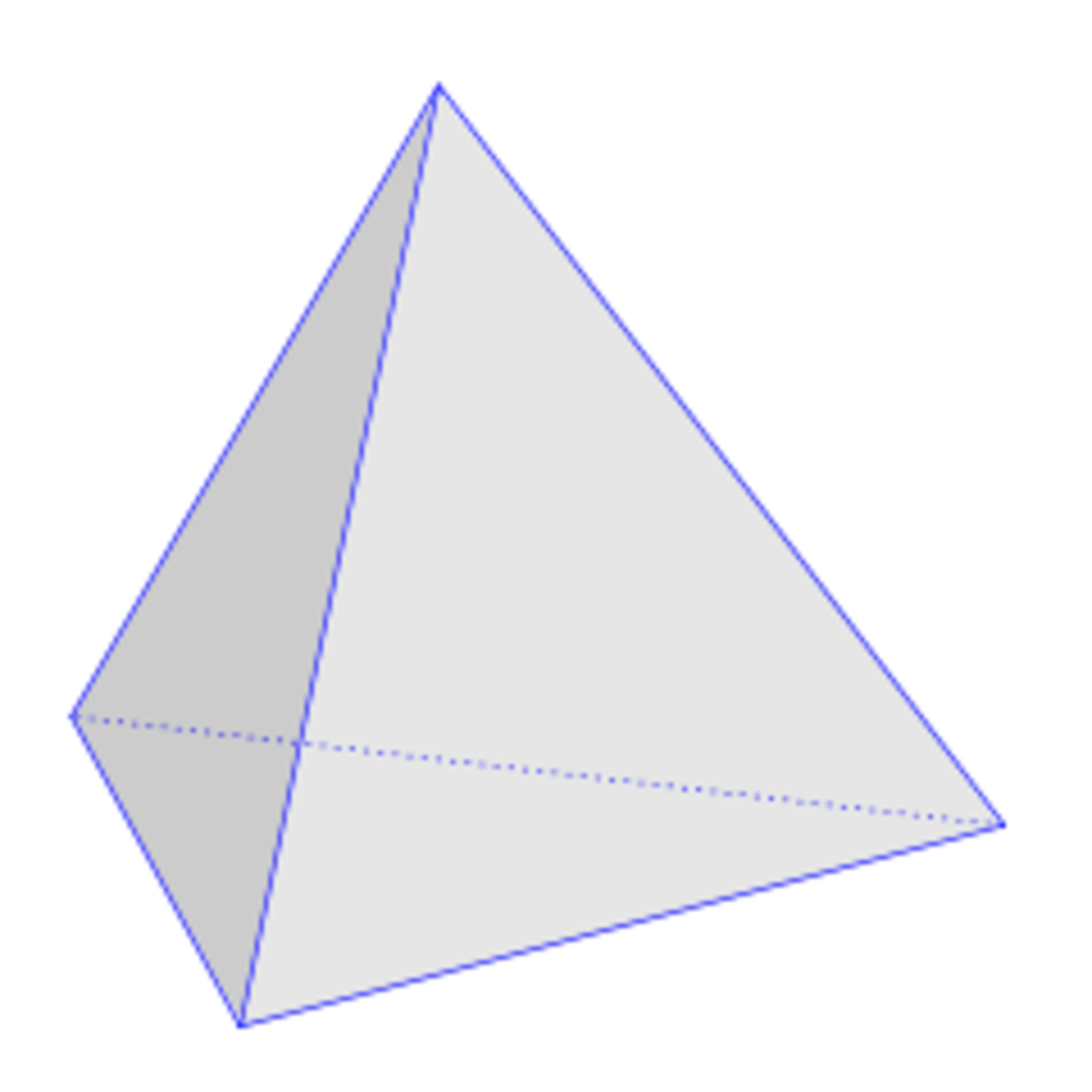Highly Irregular
Each edge of a particular tetrahedron has a length of either 5 cm or 7 cm. The minimum possible volume, in cm 3 , of such a tetrahedron can be written as c a b , where a , b , and c are positive integers, a and c are coprime, and b is square-free. Give a + b + c .

Image Credit: Wikimedia Aldoaldoz .
The answer is 63.
This section requires Javascript.
You are seeing this because something didn't load right. We suggest you, (a) try
refreshing the page, (b) enabling javascript if it is disabled on your browser and,
finally, (c)
loading the
non-javascript version of this page
. We're sorry about the hassle.
2 solutions
I can not imagine such a tetrahedron! A perspective drawing would not be bad. This could also help to explain the integration formula. ;-)
Log in to reply
Log in to reply
Oh, nice, a moving perspective sure helps.
Thank you!
Hello,,i have a problem,i want that you help me,,so . one person have 9 offspring and 31 grandchild. He has bequeathed a total of $ 470. The daughter reached $ 74. Each girl receives $ 7 more than boys. daughter,how money have girl?
please answer me please. and I'm have a question of you do you have Gmail?
One way to find the volume is using analytical geometry with base triangle on XY plane, z coordinate of the fourth vertex being the height. There is also a formula for the volume of tetrahedron.
V = 3 ! 1 2 3 1 d e t ( 1 , 0 a i j 2 , 1 )
a i j denotes an edge connecting vertex A i and A j and
d e t ( 1 , 0 a i j 2 , 1 ) = d e t ⎝ ⎜ ⎜ ⎜ ⎜ ⎛ 0 a 1 , 2 2 a 1 , 3 2 a 1 , 4 2 1 a 1 , 2 2 0 a 2 , 3 2 a 2 , 4 2 1 a 1 , 3 2 a 2 , 3 2 0 a 3 , 4 2 1 a 1 , 4 2 a 2 , 4 2 a 3 , 4 2 0 1 1 1 1 1 0 ⎠ ⎟ ⎟ ⎟ ⎟ ⎞
In our case there are 11 possible configurations:
No of Length 7 Edges | No of Configurations | Volumes
0 1 14.73
1 1 14.87
2 2 18.04 5.77
3 3 23.01 20.82 18.26
4 2 25.25 25.17
5 1 32.22
6 1 40.42
The configuration with 2 long edges opposite each other without common vertex gives lowest determinant:
d e t ⎝ ⎜ ⎜ ⎜ ⎜ ⎛ 0 5 2 5 2 7 2 1 5 2 0 7 2 5 2 1 5 2 7 2 0 5 2 1 7 2 5 2 5 2 0 1 1 1 1 1 0 ⎠ ⎟ ⎟ ⎟ ⎟ ⎞ = 9 6 0 4
resulting with volume value of 1 2 4 9 2 ≈ 5 . 7 7 .
Thanks for proving what I had only guessed at. Now I need to figure out how that works.
If we had a square of side 5 , the diagonal would be 7 . 0 7 1 0 7 . . . By making this diagonal exactly 7 , we form a rhombus, which we can crease along the shorter diagonal. Putting two such rhombuses together makes for a nearly flat tetrahedron. A little effort gets us the volume
1 2 4 9 2
as compared with the volume of a regular tetrahedron of edge 5
1 2 1 2 5 2
Edit: Here's the work to get us the volume
5 2 − 2 ( 2 7 ) 2 ∫ 0 1 7 h ( 7 − 7 h ) d h = 1 2 4 9 2
where the limits of the integration is based on using altitude h as a parameter arbitrarily from 0 to 1 , the area being a rectangle varying from 0 × 7 to 2 7 × 2 7 to 7 × 0 , while the coefficient is the ratio of the actual distance between the edges of length 7 to the parameter of arbitrary length 1 , thus scaling the volume.
Edit 2: Here's a graphic of this squeezed tetrahedron. The top and bottom of this are the long edges of length 7 , all the rest having length 5 . The distance between the long edges is 2 1 , so this tetrahedron is nearly flat. You can see how two folded rhombuses can be put together to form this tetrahedron.
Note: Finding the volume of this particular tetrahedron is easy because of its symmetry. But, in the general case, given the six arbitrary edge lengths of a tetrahedron, a , b , c , d , e , f , finding the volume is usually a gargantuan task. I suspect that Enlow did not go that way.